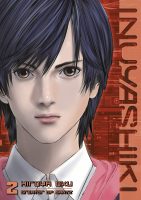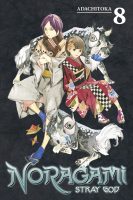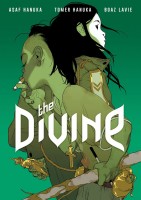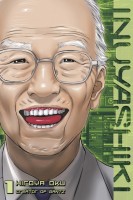My News and Reviews
Last week at Experiments in Manga I posted the Bookshelf Overload for August. I picked up some great out-of-print (or soon to be out-of-print) manga and comics last month in addition to some highly-anticipated new releases. I was particularly busy with work and taiko last week so I wasn’t online much, but there is one thing that I’d like to draw attention to–the thirty-eighth and most recent issue of Sparkler Monthly. In it is the first part of a Skyglass side story written by Jenn Grunigen and illustrated by Mookie called “The Mud God” which, in addition to being adorably cute, is partly my fault as it’s related to another Skyglass commission that the author is working on for me. (Hopefully that one will be able to be shared soon, too!)
Quick Takes
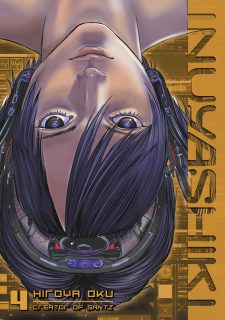 Inuyashiki, Volume 4 by Hiroya Oku. The fourth volume of Inuyashiki begins immediately where the third volume ends, with the devastating and gruesome aftermath of Inuyashiki’s confrontation with an powerful organized crime group. It then turns to follow Shishigami’s story again. One thing that I found to be particularly interesting about Inuyashiki, Volume 4 is the character development of the two main leads. Since the beginning of the series, Inuyashiki and Shishigami have been opposites, using their newly-granted powers in vastly different ways. Though they both are mechanical monsters with many of the same abilities, Inuyashiki has focused on helping others, whether that be by curing major illnesses or fighting on behalf of those who are weaker, while Shishigami has been going on killing sprees for his own selfish reasons. Inuyashiki abhors violence, even when he is a willing participant; Shishigami delights in it. But the fourth volume of Inuyashiki sees some of that change. Inuyashiki is learning to consciously use and control his more deadly powers, specifically in order to put an end to Shishigami. He still considers it to be a necessary evil, though. As for Shishigami, his mother’s illness inspires him to use his abilities for less destructive purposes, but it’s still difficult to sympathize with him since he shows very little regret or remorse for the suffering he has wrought in the recent past.
Inuyashiki, Volume 4 by Hiroya Oku. The fourth volume of Inuyashiki begins immediately where the third volume ends, with the devastating and gruesome aftermath of Inuyashiki’s confrontation with an powerful organized crime group. It then turns to follow Shishigami’s story again. One thing that I found to be particularly interesting about Inuyashiki, Volume 4 is the character development of the two main leads. Since the beginning of the series, Inuyashiki and Shishigami have been opposites, using their newly-granted powers in vastly different ways. Though they both are mechanical monsters with many of the same abilities, Inuyashiki has focused on helping others, whether that be by curing major illnesses or fighting on behalf of those who are weaker, while Shishigami has been going on killing sprees for his own selfish reasons. Inuyashiki abhors violence, even when he is a willing participant; Shishigami delights in it. But the fourth volume of Inuyashiki sees some of that change. Inuyashiki is learning to consciously use and control his more deadly powers, specifically in order to put an end to Shishigami. He still considers it to be a necessary evil, though. As for Shishigami, his mother’s illness inspires him to use his abilities for less destructive purposes, but it’s still difficult to sympathize with him since he shows very little regret or remorse for the suffering he has wrought in the recent past.
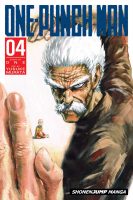 One-Punch Man, Volumes 4-8 written by One and illustrated by Yusuke Murata. I continue to be greatly impressed by both the artwork and writing of One-Punch Man although the series is not without its flaws. The manga plays around with many of the tropes of the superhero genre and makes use of plenty of stereotypes in the process. Unfortunately, that means the introduction of an unquestionably gay hero and the perceived threat of his sexuality is intended to be comedic, resulting in an uncomfortable setup in which implied sexual assault is treated as a joke. Personally, I didn’t find this to be particularly funny. However, other than that glaring misstep, the humor in One-Punch Man is fantastic. A slew of new heroes and villains have been brought in; their powers are frequently over-the-top and frankly ridiculous, fitting the overall tone of the series perfectly. Murata’s artwork can be absolutely stunning and is incredibly dynamic, shifting from simplified illustrations to those that are nearly photo-realistic depending on the needs of the story and humor. The action sequences are great, filled with intense battles between absurdly powered opponents and accompanied by a suitably tremendous amount of destruction. It’s not at all surprising that One-Punch Man has been adapted into an anime series–the manga as a whole but especially the visual components seem to beg for it.
One-Punch Man, Volumes 4-8 written by One and illustrated by Yusuke Murata. I continue to be greatly impressed by both the artwork and writing of One-Punch Man although the series is not without its flaws. The manga plays around with many of the tropes of the superhero genre and makes use of plenty of stereotypes in the process. Unfortunately, that means the introduction of an unquestionably gay hero and the perceived threat of his sexuality is intended to be comedic, resulting in an uncomfortable setup in which implied sexual assault is treated as a joke. Personally, I didn’t find this to be particularly funny. However, other than that glaring misstep, the humor in One-Punch Man is fantastic. A slew of new heroes and villains have been brought in; their powers are frequently over-the-top and frankly ridiculous, fitting the overall tone of the series perfectly. Murata’s artwork can be absolutely stunning and is incredibly dynamic, shifting from simplified illustrations to those that are nearly photo-realistic depending on the needs of the story and humor. The action sequences are great, filled with intense battles between absurdly powered opponents and accompanied by a suitably tremendous amount of destruction. It’s not at all surprising that One-Punch Man has been adapted into an anime series–the manga as a whole but especially the visual components seem to beg for it.
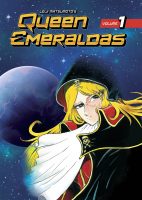 Queen Emeraldas, Volume 1 by Leiji Matsumoto. Older manga are not often released in English, so I was very excited to learn that Kodansha Comics would be publishing a classic series. I was even more interested when I found out that series would be Matsumoto’s space opera Queen Emeraldas which takes place in the same universe as his Captain Harlock stories. Although the hardcover English-language edition is based on a Japanese release from 2009, Queen Emeraldas was originally serialized in the late 1970s. The story largely follows a young man by the name of Hiroshi Umino, a runaway from Earth who crash lands on Mars in a spaceship he cobbled together himself. The titular Emeraldas is charismatic and enigmatic woman, a living legend who metes out justice as she wanders the stars. She takes a particular interest in the boy, repeatedly aiding him in his struggle to survive in space. Initially her concern seems to emerge from the fact that his story shares so many similarities with her own although later it is implied that she may have a deeper connection to him. However, like much of Queen Emeraldas, the nature of that connection is still a mystery. So far, I am thoroughly enjoying Queen Emeraldas. The manga is moody, atmospheric, and melancholic with a Western frontier flair. The characters are ambitious, seeking a life of freedom in a world that is harsh and unforgiving.
Queen Emeraldas, Volume 1 by Leiji Matsumoto. Older manga are not often released in English, so I was very excited to learn that Kodansha Comics would be publishing a classic series. I was even more interested when I found out that series would be Matsumoto’s space opera Queen Emeraldas which takes place in the same universe as his Captain Harlock stories. Although the hardcover English-language edition is based on a Japanese release from 2009, Queen Emeraldas was originally serialized in the late 1970s. The story largely follows a young man by the name of Hiroshi Umino, a runaway from Earth who crash lands on Mars in a spaceship he cobbled together himself. The titular Emeraldas is charismatic and enigmatic woman, a living legend who metes out justice as she wanders the stars. She takes a particular interest in the boy, repeatedly aiding him in his struggle to survive in space. Initially her concern seems to emerge from the fact that his story shares so many similarities with her own although later it is implied that she may have a deeper connection to him. However, like much of Queen Emeraldas, the nature of that connection is still a mystery. So far, I am thoroughly enjoying Queen Emeraldas. The manga is moody, atmospheric, and melancholic with a Western frontier flair. The characters are ambitious, seeking a life of freedom in a world that is harsh and unforgiving.
 Yamada-kun and the Seven Witches, Volume 9 by Miki Yoshikawa. It’s fairly common for bodyswap manga to incorporate a fair amount of fanservice, especially when different genders are involved, and Yamada-kun and the Seven Witches is no exception to that trend. Generally, the fanservice in the series doesn’t bother me that much especially considering the context, but every once in a while it’s more of a distraction than anything else. A case in point is a completely inexplicable panty shot in the ninth volume which completely threw me out of the story; it served no purpose for either characterization or plot, and even how the scene was illustrated didn’t make any sense. Usually, Yoshikawa is much better than that. Otherwise, I really enjoyed the ninth volume of Yamada-kun and the Seven Witches. There are some interesting twists and revelations as Yamada tries to find a way to return everyone’s missing memories. I’m not always very fond of amnesia plotlines in stories simply because they can be a lazy way for creators to write themselves out of a corner or cause unnecessary drama, but in the case of Yamada-kun and the Seven Witches it actually works really well. At it’s very heart the series about friendship and overcoming isolation. Yamada, intentionally or not, was the one who brought so many of the characters together in the first place and he will do everything that he can to bring them together again.
Yamada-kun and the Seven Witches, Volume 9 by Miki Yoshikawa. It’s fairly common for bodyswap manga to incorporate a fair amount of fanservice, especially when different genders are involved, and Yamada-kun and the Seven Witches is no exception to that trend. Generally, the fanservice in the series doesn’t bother me that much especially considering the context, but every once in a while it’s more of a distraction than anything else. A case in point is a completely inexplicable panty shot in the ninth volume which completely threw me out of the story; it served no purpose for either characterization or plot, and even how the scene was illustrated didn’t make any sense. Usually, Yoshikawa is much better than that. Otherwise, I really enjoyed the ninth volume of Yamada-kun and the Seven Witches. There are some interesting twists and revelations as Yamada tries to find a way to return everyone’s missing memories. I’m not always very fond of amnesia plotlines in stories simply because they can be a lazy way for creators to write themselves out of a corner or cause unnecessary drama, but in the case of Yamada-kun and the Seven Witches it actually works really well. At it’s very heart the series about friendship and overcoming isolation. Yamada, intentionally or not, was the one who brought so many of the characters together in the first place and he will do everything that he can to bring them together again.


